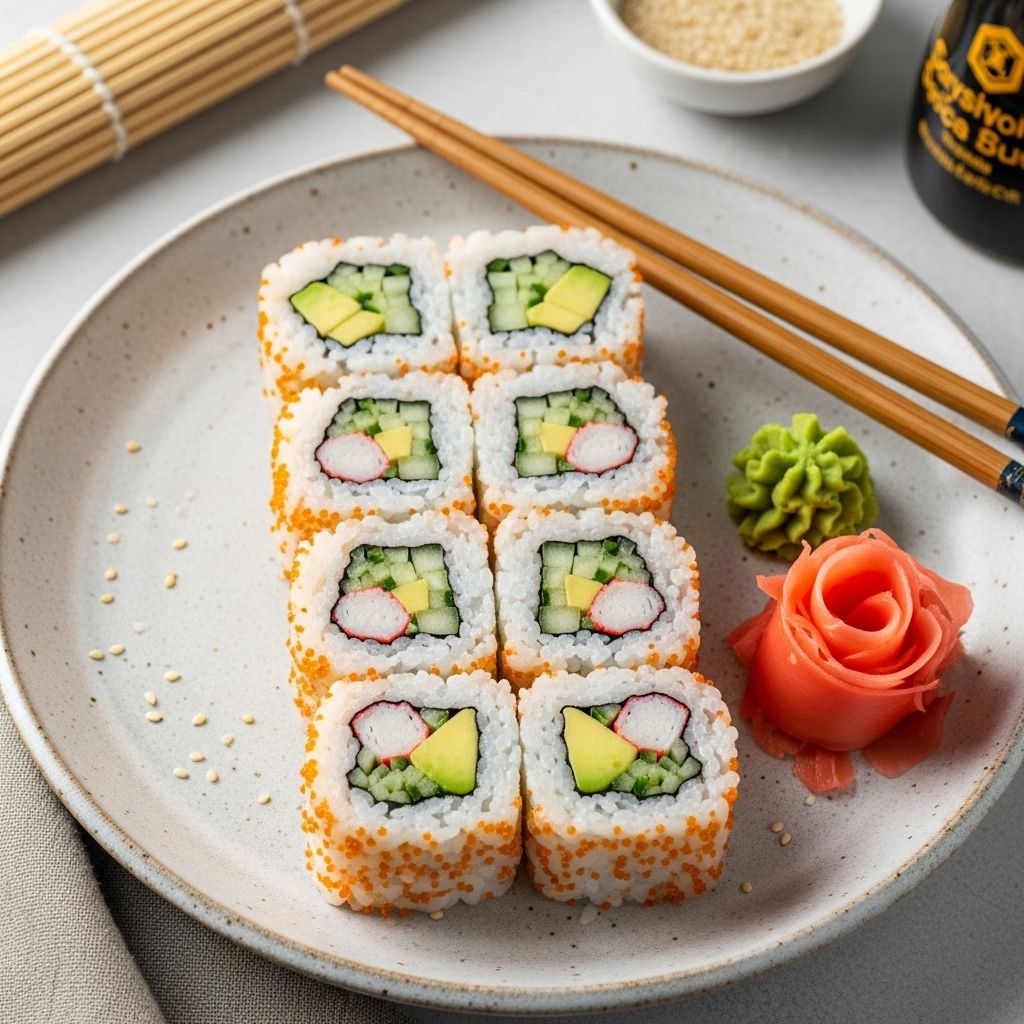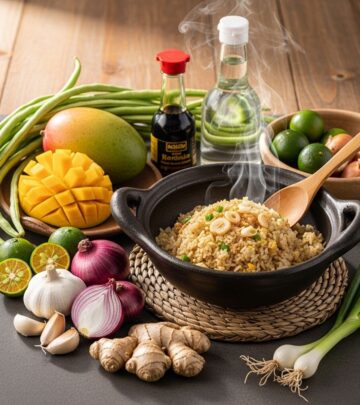California Roll Recipe: Easy Homemade Step-By-Step Guide
Master the art of rolling delicious California rolls with fresh ingredients, expert tips, and step-by-step guidance for sushi success.

Image: HearthJunction Design Team
California Roll Recipe: A Step-by-Step Guide for Sushi Lovers
California rolls are a sushi classic that brings together creamy avocado, crisp cucumber, and sweet crab (or imitation crab) rolled up in seasoned rice and nori. Whether you’re a sushi aficionado or just getting started, this comprehensive guide will equip you to craft California rolls just like your favorite sushi bar, all from the comfort of home.
Table of Contents
- About California Rolls
- Ingredients
- Equipment You’ll Need
- Step-by-Step Instructions
- Pro Tips for Success
- Serving Suggestions & Dipping Sauces
- Frequently Asked Questions
- Nutrition Information
About California Rolls
The California roll is a type of maki sushi (rolled sushi) that traditionally features imitation crab, avocado, and cucumber wrapped in sushi rice and nori (seaweed). It’s often made with the rice on the outside (uramaki style) and rolled in a sprinkle of sesame seeds. This fusion dish was created in the 1960s–70s in California, quickly becoming a global favorite for its approachable ingredients and irresistible flavor combination.
Ingredients
Gather these ingredients to make about four California rolls (serves 2–4):
- 2 cups sushi rice (uncooked; yields about 4 cups cooked)
- 1/4 cup seasoned rice vinegar
- 4 sheets nori (seaweed)
- 8 sticks imitation crab (kanikama) or cooked real crab meat
- 1 ripe avocado, peeled, pitted, and sliced
- 1/2 cucumber, peeled and julienned
- 2–3 teaspoons toasted sesame seeds
- Optional: Kewpie or regular mayonnaise for classic crab salad flavor
For Serving
- Soy sauce
- Wasabi paste
- Pickled ginger (gari)
- Optional: Spicy mayo (mix mayonnaise and sriracha to taste)
Equipment You’ll Need
- Bamboo sushi rolling mat (makisu)
- Plastic wrap (to cover the mat and prevent sticking)
- Sharp knife (for clean slices)
- Small bowl of water (to wet hands and knife)
- Cutting board
Step-by-Step Instructions
1. Cook and Prepare Sushi Rice
- Place 2 cups of sushi rice in a bowl and rinse under cold water several times until the water runs clear. Drain well.
- In a rice cooker: Add rinsed rice and 2 1/2 cups water. Cook according to manufacturer instructions (white rice setting) until tender.
- On the stovetop: Combine the rinsed rice and 2 cups cold water in a heavy saucepan. Cover tightly and bring to a boil over high heat. Once boiling, reduce heat to low and cook for 7–8 minutes, or until water is absorbed. Keep covered and let stand for 15 minutes off heat.
- While still warm, transfer rice to a large non-metallic bowl. Gently break up the clumps.
- Stir in 1/4 cup seasoned rice vinegar while rice is still warm. Let cool to room temperature before using.
2. Prepare Fillings
- Slice the avocado into thin strips.
- Peel the cucumber and cut into long, thin julienne strips.
- Separate the imitation crab sticks or real crab meat into manageable pieces. Mix with a small amount of mayo if desired for extra creaminess.
3. Set Up Your Rolling Station
- Cover your bamboo rolling mat in plastic wrap for easy cleanup and to prevent sticking.
- Place a small bowl of water nearby for wetting your hands and knife.
- Lay out your nori sheets, shiny side down.
4. Assemble the Rolls (Uramaki Style – Rice on the Outside)
- With dry hands, place a half or full nori sheet (depending on preference for roll size) on the mat, rough side facing up.
- Wet your hands to prevent sticking, then take about 3/4 cup cooled sushi rice and spread evenly over the nori, leaving a 1/2 inch border at the top edge.
- Sprinkle sesame seeds evenly over the rice.
- Flip the nori sheet so the rice side faces down on the plastic-covered mat.
- Arrange avocado, cucumber strips, and crab along the center of the nori (on the side closest to you).
- Lift the edge of the mat closest to you and roll it over the fillings, tucking them in with your fingers. Gently squeeze and pull the mat as you roll to shape and compress the sushi.
- Roll until you reach the exposed border. Press gently to seal the roll.
5. Slice and Serve
- Use a sharp, wet knife to slice the roll into 6–8 even pieces. Clean and re-wet the knife between cuts for clean slices.
- Arrange the pieces on a platter, cut side up.
Pro Tips for Sushi Success
- Rice texture: Don’t skip rinsing the rice; it removes excess starch and prevents gummy results.
- Avocado color: Slice avocado just before rolling to avoid browning. If prepping ahead, squeeze a little lemon over the slices.
- Don’t overfill: Too much filling makes the roll hard to seal and difficult to slice cleanly.
- Keep hands wet: Wet fingers prevent the rice from sticking to your hands but avoid making them too wet (which can make rice soggy).
- Knife care: Keep your knife wet and use a gentle sawing motion for neat, even pieces.
Serving Suggestions & Dipping Sauces
- Soy sauce: Classic for dipping.
- Wasabi: For a kick of heat; mix a bit into your soy sauce if desired.
- Pickled ginger (gari): Cleanses the palate between bites.
- Spicy mayo: Blend mayonnaise with a small amount of sriracha or hot sauce for a creamy, spicy dip.
Nutrition Information (Approximate, per 8-piece roll)
| Nutrient | Amount |
|---|---|
| Calories | 300–350 |
| Carbohydrates | 55g |
| Protein | 6–8g |
| Fat | 6–9g |
| Sodium | 400–500mg |
Nutrition values will vary based on portion size, rice quantity, and specific ingredient brands.
Frequently Asked Questions (FAQs)
Can I use real crab instead of imitation crab?
Absolutely! Real crab (such as Dungeness crab or blue crab) makes for a sweeter, more luxurious California roll, although imitation crab is more common and less expensive.
How do I keep my California rolls from falling apart?
Use enough rice to cover the nori in a thin layer, don’t overfill with ingredients, and squeeze the roll firmly (but not too hard) as you roll with the mat. Wetting the knife makes slicing much easier and neater.
Is California roll gluten-free?
The roll itself is gluten-free if you use gluten-free imitation crab and soy sauce. Always check labels, as many imitation crab brands contain wheat.
How long do homemade California rolls last?
They are best consumed fresh, but you can store tightly wrapped leftover rolls in the refrigerator for up to 24 hours. Note that the rice will firm up and the avocado may brown over time.
I don’t have a bamboo mat. What can I use?
If you don’t own a bamboo mat, try using parchment paper, a flexible silicone mat, or even a clean kitchen towel wrapped in plastic wrap to roll your sushi.
Can I make California rolls vegan?
Yes. Substitute imitation crab with seasoned tofu, shredded carrots, or other plant-based fillings for a vegan-friendly roll while keeping the creamy avocado and crisp cucumber.
Conclusion
Once you master the basics of making California rolls, you can experiment with fillings, toppings, and even rolling styles to create your perfect sushi at home. Practice makes perfect, so gather your ingredients, invite some friends or family, and enjoy a sushi-making night that’s as fun as it is delicious!
References
Read full bio of Srija Burman












